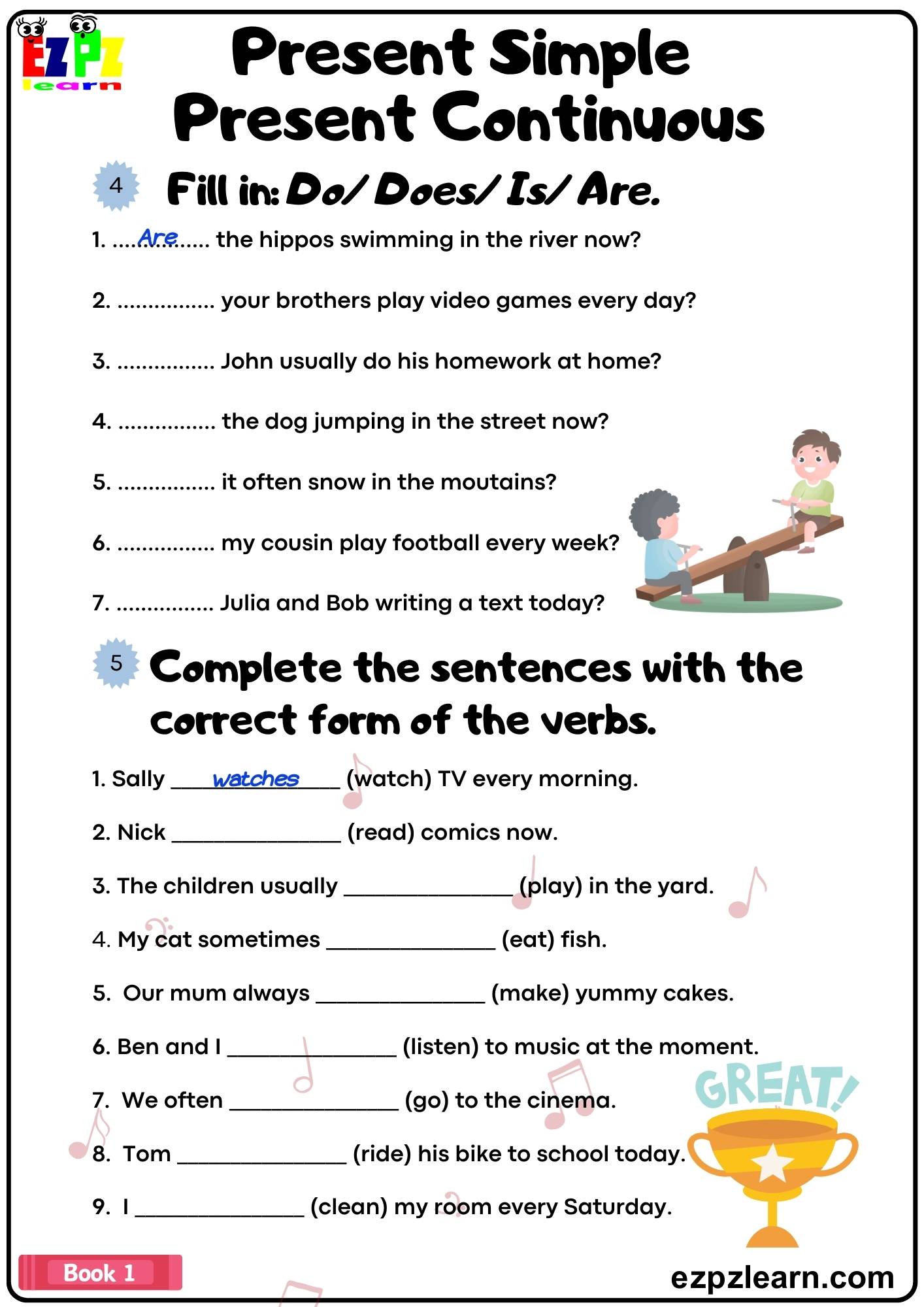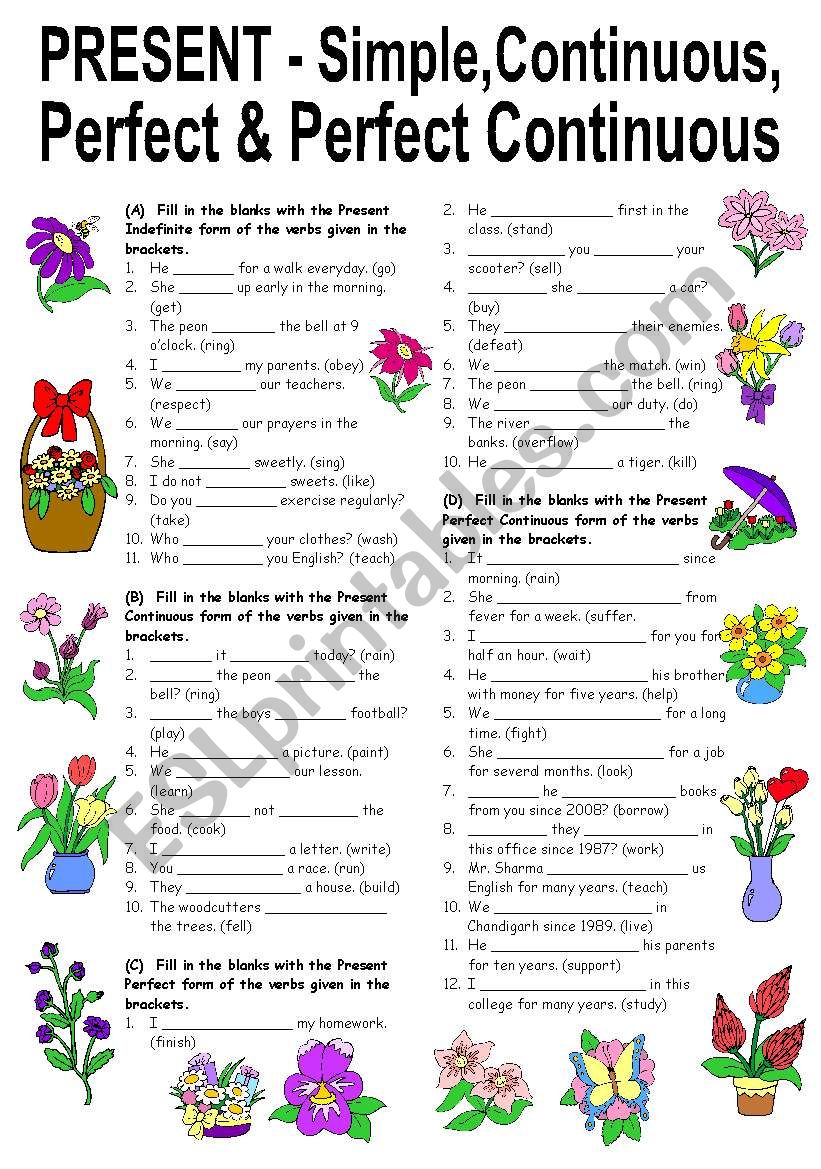
Mastering English Tenses: The Indispensable Role of Present Simple and Continuous Worksheets with Answers
English grammar, with its intricate web of rules and exceptions, often presents a significant challenge for learners worldwide. Among the foundational concepts, the Present Simple and Present Continuous tenses stand out as crucial building blocks. They are the bedrock upon which much of everyday communication is constructed, enabling us to talk about facts, habits, ongoing actions, and even future plans. However, distinguishing between their nuances and applying them correctly in various contexts requires consistent practice. This is precisely where Present simple and continuous worksheets with answers become an invaluable resource, offering a structured, self-correcting path to mastery.
This comprehensive article will delve into the intricacies of these two essential tenses, explore the myriad benefits of using well-designed worksheets, provide insights into creating and utilizing them effectively, and ultimately demonstrate why Present simple and continuous worksheets with answers are indispensable tools for both learners and educators.
The Cornerstone of English Grammar: Present Simple and Present Continuous

Before we explore the utility of worksheets, let’s briefly recap the core functions and forms of these two tenses.

The Present Simple: Facts, Habits, and Routines

The Present Simple is arguably the most fundamental tense in English. It’s used to describe:

- General Truths and Facts: Things that are always true.
- Example: The sun rises in the east. Water boils at 100 degrees Celsius.
- Habits and Routines: Actions that happen regularly or repeatedly.

- Example: I drink coffee every morning. She usually walks to work.

- Schedules and Timetables: Fixed events, especially for public transport, cinema, etc.

- Example: The train leaves at 7 PM. The movie starts at 8 o’clock.

- States (with Stative Verbs): Verbs that describe states rather than actions (e.g., know, believe, love, hate, understand, seem, possess).
- Example: I know the answer. She loves chocolate.

Form:
- Positive: Base form of the verb (e.g., I work, you play, we read, they live). For third person singular (he, she, it), add -s or -es (e.g., he works, she plays, it reads).
- Negative: Use "do not" (don’t) or "does not" (doesn’t) + base form (e.g., I don’t work, she doesn’t play).
- Questions: Use "Do" or "Does" + subject + base form (e.g., Do you work? Does she play?).
The Present Continuous: Actions in Progress and Temporary Situations
The Present Continuous (also known as Present Progressive) describes actions that are happening at the moment of speaking or are temporary in nature. It’s used for:
- Actions Happening Now: What someone is doing right at this moment.
- Example: I am writing an article. They are watching TV.
- Temporary Situations: Actions that are ongoing but not necessarily permanent.
- Example: She is living with her aunt this month. He is working on a new project these days.
- Changing or Developing Situations: Trends or processes.
- Example: The climate is changing rapidly. The economy is growing.
- Definite Future Arrangements: Plans that have been made and confirmed.
- Example: We are meeting Sarah tomorrow. They are flying to Paris next week. (Often interchangeable with "going to" future).
Form:
- Positive: Subject + "to be" (am/is/are) + verb-ing (present participle) (e.g., I am working, she is playing, they are reading).
- Negative: Subject + "to be" (am/is/are) + not + verb-ing (e.g., I am not working, she isn’t playing).
- Questions: "To be" (Am/Is/Are) + subject + verb-ing (e.g., Are you working? Is she playing?).
The Invaluable Role of Present Simple and Continuous Worksheets with Answers
Given the distinct uses and forms of these two tenses, learners often struggle with choosing the correct one, especially when both seem plausible in a given context. This is where dedicated practice becomes paramount, and Present simple and continuous worksheets with answers rise to the occasion as a highly effective learning tool.
Why Worksheets Are Essential for Mastery:
- Reinforced Learning: Worksheets provide repetitive exposure to the rules and structures, embedding them more deeply in the learner’s mind. Through varied exercises, students practice applying the tenses in different scenarios.
- Active Engagement: Unlike passively reading grammar rules, completing worksheets requires active participation, forcing learners to think critically and make decisions about tense usage.
- Identification of Weaknesses: By attempting exercises, learners quickly discover which aspects of the tenses they haven’t fully grasped. Is it the third-person ‘s’? The use of ‘do/does’? Or distinguishing between habitual actions and temporary ones?
- Self-Correction and Immediate Feedback: The "with answers" component is crucial. It allows learners to check their work immediately, understand their mistakes, and correct them. This instant feedback loop is far more effective than waiting for a teacher’s correction days later, as it solidifies the correct usage on the spot.
- Building Confidence: Successfully completing exercises and verifying answers builds confidence. This positive reinforcement encourages learners to tackle more complex grammar concepts.
- Structured Practice: Worksheets typically progress in difficulty, starting with basic fill-in-the-blanks and moving towards more complex sentence construction or error correction, providing a structured learning path.
- Versatility for Teachers and Learners: Teachers can use them for in-class activities, homework, or assessments. Learners can use them for self-study, revision, or supplementary practice.
Designing and Utilizing Effective Present Simple and Continuous Worksheets with Answers
Not all worksheets are created equal. An effective worksheet is thoughtfully designed to target specific learning objectives and provide clear opportunities for practice and self-assessment.
Key Elements of High-Quality Worksheets:
-
Variety of Exercise Types:
- Fill-in-the-blanks: Basic, for reinforcing correct forms (e.g., "She __ (go) to school every day.").
- Multiple Choice: For distinguishing between tenses in context (e.g., "I usually [walk/am walking] to work, but today I [take/am taking] the bus.").
- Sentence Transformation: Changing a sentence from one tense to another, or from positive to negative/question.
- Error Correction: Identifying and correcting mistakes in sentences, which is excellent for highlighting common pitfalls.
- Picture Description: Describing what people are doing in a picture (often present continuous) versus what they usually do (present simple).
- Dialogue Completion: Filling in missing parts of a conversation using appropriate tenses.
- Open-ended Questions: Encouraging learners to produce their own sentences, applying the tenses in a more creative way.
-
Clear Instructions: Ambiguous instructions can hinder learning. Ensure they are concise and easy to understand.
-
Contextualized Examples: Grammar is best learned when applied in meaningful contexts. Use sentences that reflect real-life situations.
-
Progressive Difficulty: Start with simpler exercises focusing on form, then gradually introduce more complex scenarios requiring the application of usage rules, especially the crucial distinction between the two tenses.
-
Focus on Stative Verbs: A dedicated section or specific exercises addressing stative verbs (e.g., "know," "believe," "love," "seem," "own") is vital. These verbs typically do not take continuous forms, and this is a common area of confusion for learners. Worksheets that specifically challenge learners to use the simple present with stative verbs are highly effective.
-
Comprehensive Answers: The "with answers" part cannot be overstressed. The answers should be clear, correct, and preferably easy to cross-reference with the questions. For more complex exercises, brief explanations for the answers can be extremely helpful.
How to Maximize the Benefits of Worksheets:
-
For Learners:
- Don’t Peek: Try to complete the exercises without looking at the answers first.
- Self-Assess Honestly: Once finished, compare your answers. Don’t just mark wrong answers; try to understand why they were wrong.
- Review and Re-do: If you struggle with a particular type of exercise, review the rules and try similar exercises later.
- Integrate with Other Skills: After completing a worksheet, try to apply the tenses in your speaking and writing. Describe your daily routine (Present Simple) or what you are doing right now (Present Continuous).
-
For Educators:
- Differentiate: Provide worksheets of varying difficulty levels to cater to different learner needs within a class.
- Pre- and Post-Assessments: Use worksheets as diagnostic tools before teaching a topic and as summative assessments afterward.
- Interactive Activities: Turn worksheet exercises into pair or group work activities, encouraging peer teaching and discussion.
- Supplement, Don’t Replace: Worksheets are excellent for practice, but they should complement other teaching methods like communicative activities, role-playing, and real-life usage scenarios.
Where to Find and How to Create Excellent Present Simple and Continuous Worksheets with Answers
The internet is a treasure trove of resources for ESL/EFL learners and teachers. Many reputable websites offer free, printable Present simple and continuous worksheets with answers. Websites dedicated to English grammar, ESL teaching resources, and educational publishers often have extensive libraries. Textbooks also come with accompanying workbooks that contain excellent practice exercises.
For those who prefer to tailor content to specific learner needs, creating your own worksheets is also a viable option. Start by identifying common errors your students make, then design exercises that specifically target those areas. Use authentic materials like short news articles, song lyrics, or simple stories as inspiration for contextualized sentences. Remember to always provide clear answers for self-correction.
Conclusion: The Path to Fluency Through Practice
Mastering the Present Simple and Present Continuous tenses is a fundamental step on the journey to English fluency. These tenses allow us to communicate a vast range of information about our daily lives, the world around us, and our plans. While understanding the rules is essential, true mastery comes from consistent and targeted practice.
Present simple and continuous worksheets with answers provide an effective, self-directed, and invaluable pathway to achieving this mastery. They offer structured repetition, immediate feedback, and the opportunity for learners to identify and overcome their specific grammatical hurdles. For educators, they are versatile tools for reinforcement, assessment, and differentiation. By embracing these powerful resources, both learners and teachers can confidently navigate the complexities of English tenses, paving the way for clearer, more accurate, and ultimately more confident communication.
